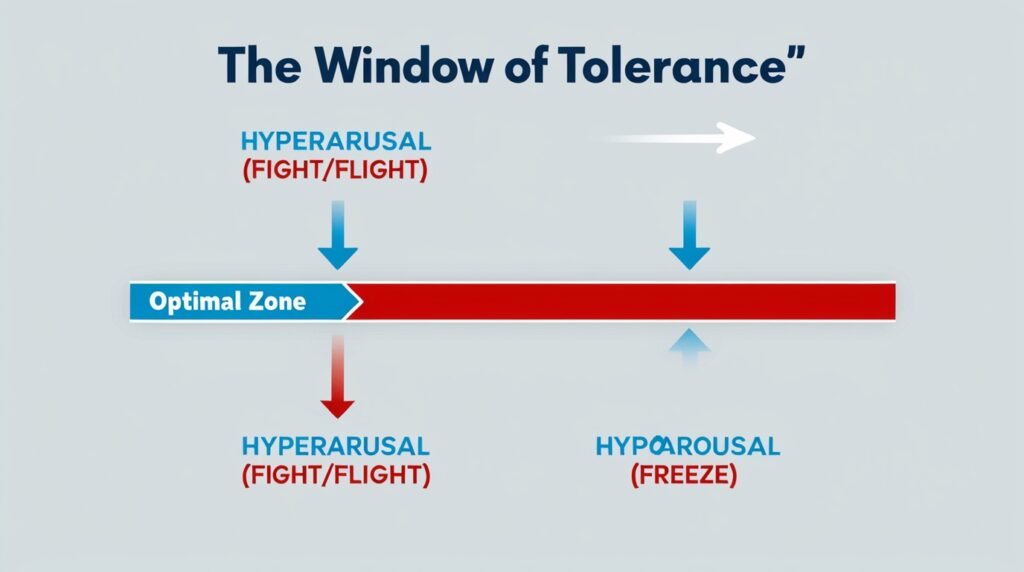Window of Tolerance for Kids: Understanding and Supporting Emotional Regulation
Introduction to the Window of Tolerance for Kids
Window of Tolerance for Kids Have you ever noticed how some kids can bounce back from frustration easily while others spiral into tears or anger? That’s where the “window of tolerance” comes in — a psychological concept that explains how much emotional stress a person can handle before becoming overwhelmed or shut down. For children, this concept is especially important because their brains and emotional systems are still developing.
The window of tolerance represents the optimal state where a child can function, learn, and connect with others effectively. When kids are within this window, they can handle challenges, regulate emotions, and communicate their needs. But when stress pushes them beyond this window, they might react with meltdowns (hyperarousal) or withdrawal (hypoarousal).
Understanding this concept helps parents, teachers, and caregivers respond with empathy instead of frustration. It’s not that a child won’t behave — often, it’s that they can’t in that moment. When a child’s nervous system feels threatened or overwhelmed, logic and reasoning go offline, and emotional survival takes over.
For instance, imagine a 6-year-old trying to complete a puzzle. If they can’t fit a piece and stay calm while trying again, they’re in their window of tolerance. But if they throw the puzzle across the room or burst into tears, they’ve stepped out of it. Recognizing this shift helps adults guide them back into balance.
The beauty of understanding this concept is that it allows adults to see behavior as communication, not defiance. Every tantrum, every withdrawal, every outburst is a clue — a message that a child’s nervous system needs support, not punishment.
What Is the Window of Tolerance?

Coined by Dr. Dan Siegel, the Window of Tolerance refers to the emotional zone in which a person can function optimally — calm, alert, and socially engaged. For kids, this window varies in size depending on age, temperament, environment, and past experiences.
When kids are within their window, they can think clearly, play creatively, and interact positively. Their bodies feel calm yet alert, and their minds are open to learning. However, when stressors exceed what they can handle, they move above (hyperarousal) or below (hypoarousal) this window.
Here’s how it breaks down:
| Emotional State | Description | Typical Behavior |
|---|---|---|
| Within Window | Calm, focused, engaged | Plays, learns, communicates |
| Hyperarousal (Above) | Overwhelmed, anxious, reactive | Yelling, crying, aggression |
| Hypoarousal (Below) | Numb, disconnected, shut down | Withdrawal, lack of response |
Understanding these states is key for helping children grow emotionally resilient. A child’s window of tolerance isn’t fixed — it can expand over time through safety, connection, and supportive strategies. When adults respond with calm and empathy, they help regulate the child’s nervous system, teaching them how to self-regulate in the future.
Why It Matters for Children’s Emotional Health
A wide window of tolerance allows kids to handle life’s ups and downs with confidence. When they can recover from frustration or disappointment, they develop resilience — the ability to bounce back from challenges. But when a child’s window is too narrow, even small stressors can feel catastrophic.
Children who struggle to stay within their window may face issues like:
- Frequent emotional outbursts
- Trouble focusing or learning
- Anxiety or withdrawal in social settings
- Low self-esteem
The good news is that emotional regulation can be taught and nurtured. With consistent support, children can expand their window of tolerance, leading to healthier relationships, better learning outcomes, and overall well-being.
When kids feel safe, understood, and supported, their nervous system learns that it’s okay to experience strong emotions without being consumed by them. They discover that emotions are temporary and manageable — an essential life skill for thriving in school and beyond.
Understanding How the Brain Regulates Emotions
Emotional regulation begins in the brain. For children, understanding this process is like learning how the control panel of their feelings works. Two key brain areas play a role here: the amygdala and the prefrontal cortex.
The amygdala acts like an alarm system — it detects danger or stress. The prefrontal cortex, on the other hand, helps with decision-making, impulse control, and problem-solving. In kids, the prefrontal cortex is still developing, which is why their reactions can seem big and unpredictable.
When stress hits, the amygdala can hijack control, leading to a “fight, flight, or freeze” response. This is what happens when a child starts yelling, crying, or shutting down. Only when they feel safe again does the prefrontal cortex come back online, allowing reasoning and learning to resume.
The nervous system also plays a big part. The sympathetic nervous system triggers hyperarousal (fight or flight), while the parasympathetic system helps calm the body down (rest and digest). Emotional balance happens when these systems work in harmony.
By teaching children simple ways to calm their bodies — deep breathing, movement, or mindful breaks — we help them engage their parasympathetic system and return to their window of tolerance.
Signs a Child Is Within, Above, or Below Their Window of Tolerance
Recognizing where a child is emotionally can make all the difference. Children don’t always have the words to express what’s going on inside, so their behavior becomes the clearest signal.
When a child is within their window, they appear calm, curious, and engaged. They can play, focus, and follow directions. Their body language is relaxed, and their voice tone is even.
When above the window (hyperarousal):
- They might yell, argue, or cry.
- Their breathing becomes shallow.
- They may have difficulty listening or sitting still.
- They can appear defiant, but they’re really overwhelmed.
When below the window (hypoarousal):
- They withdraw or seem “spaced out.”
- They may speak softly or not at all.
- They avoid eye contact.
- Their body seems heavy or slow.
By tuning into these cues, adults can meet children where they are — not by demanding calm, but by helping them find it again through connection, empathy, and regulation.
Common Triggers That Push Kids Out of Their Window of Tolerance
Every child has their own unique triggers — experiences or situations that cause stress or overwhelm. These triggers can be environmental, emotional, or even internal. Understanding them is the first step to preventing meltdowns and supporting emotional growth.
Environmental Stressors
Environmental factors can have a huge impact on a child’s emotional state. For instance, loud noises, bright lights, crowded spaces, or unexpected changes in routine can easily push a sensitive child beyond their window of tolerance. A noisy classroom, a sibling shouting, or even a new environment can feel like sensory overload.
Some children are more sensitive than others, especially those with sensory processing differences or neurodiverse conditions like autism or ADHD. When the environment becomes too stimulating, their nervous system enters a state of hyperarousal — meaning they feel anxious, irritable, or out of control.
To reduce environmental triggers:
- Create calm, predictable spaces with soft lighting and minimal clutter.
- Use routines to make transitions smoother.
- Offer noise-canceling headphones or quiet corners for breaks.
- Be mindful of sensory needs, such as clothing textures or strong smells.
Small changes can make a big difference in helping kids stay regulated throughout the day.
Emotional and Social Triggers
Children are deeply social beings, and relationships play a vital role in their emotional stability. Social rejection, teasing, criticism, or even perceived disapproval can quickly narrow a child’s window of tolerance. Kids thrive on connection and validation — when that feels threatened, their brain perceives danger.
For example, a child who feels embarrassed after making a mistake in class might respond with anger (hyperarousal) or retreat (hypoarousal). Similarly, being ignored or misunderstood at home can trigger feelings of loneliness or fear.
Parents and teachers can support emotional safety by:
- Listening without judgment.
- Offering empathy before advice (“That must have felt really hard.”).
- Encouraging open communication about feelings.
- Teaching repair after conflict, not punishment.
These practices help children feel emotionally secure, keeping them within their window.
The Impact of Trauma and Unmet Needs
Trauma — whether big or small — can significantly shrink a child’s window of tolerance. This includes not only obvious traumatic events but also chronic stress, neglect, or inconsistency. When a child’s brain learns that the world is unpredictable or unsafe, their nervous system remains on high alert.
Unmet needs — such as hunger, fatigue, or lack of emotional attention — can also act as silent triggers. For instance, a child who hasn’t slept enough or skipped breakfast might appear defiant or distracted, when in reality, their body simply lacks the resources to stay regulated.
Adults can help by:
- Ensuring basic physical needs are met.
- Providing consistent routines.
- Building trust through reliability and warmth.
When children feel physically and emotionally secure, their window naturally widens, allowing them to handle challenges more effectively.
Helping Kids Stay Within Their Window of Tolerance

Supporting a child’s emotional balance doesn’t mean preventing all stress — it means helping them manage it in healthy ways. Every child needs to experience small amounts of stress to build resilience, but they also need safety, understanding, and guidance to navigate it.
Creating a Safe and Predictable Environment
Children thrive in predictability. When they know what to expect, their brains feel safe, and they can focus on learning and playing instead of scanning for threats. Chaos or unpredictability, on the other hand, can make their nervous systems go into overdrive.
Ways to create predictability:
- Use visual schedules for routines (morning, bedtime, etc.).
- Give warnings before transitions, such as “In five minutes, we’ll clean up.”
- Keep household or classroom rules clear and consistent.
- Model calm responses during stressful moments.
A consistent environment acts like an anchor — it keeps children grounded, especially when emotions run high.
Teaching Emotional Awareness and Vocabulary
Children can’t manage emotions they can’t name. Teaching emotional awareness starts with helping kids recognize and label what they feel. Simple activities like using “feelings charts” or books about emotions help them connect bodily sensations to words.
For example:
- “My tummy feels tight — I might be nervous.”
- “My face feels hot — I’m angry.”
- “I feel heavy — maybe I’m sad.”
Once kids can name their emotions, they gain power over them. They learn that feelings are signals, not enemies. Parents and teachers can model this by verbalizing their own emotions:
“I’m feeling frustrated, so I’m going to take a deep breath.”
This teaches kids that emotions are normal and manageable.
The Role of Co-Regulation
Before children can self-regulate, they need to co-regulate — meaning they rely on an adult’s calm presence to find their own balance. When a child is upset, your calm nervous system can help soothe theirs. Think of it like emotional Wi-Fi — your calm connects with their chaos.
Practical co-regulation strategies include:
- Maintaining a calm tone and steady breathing.
- Offering gentle physical contact if appropriate (like a hug or hand on the shoulder).
- Speaking slowly and reassuringly.
- Helping the child identify what they need: “Would you like a break or a cuddle?”
Over time, repeated experiences of co-regulation strengthen a child’s brain pathways for self-regulation. They learn, through experience, that it’s possible to move from upset to calm safely.
Practical Techniques to Expand a Child’s Window of Tolerance
Just like muscles grow stronger with exercise, a child’s capacity for emotional regulation expands with practice. These techniques help build resilience and widen the window of tolerance so that stress feels more manageable over time.
Breathing and Mindfulness Exercises
Breathing techniques are powerful because they directly affect the nervous system. When a child takes slow, deep breaths, their body sends a message to the brain that it’s safe to relax.
Try these:
- Balloon Breathing: Pretend to blow up a big balloon, inhaling deeply and exhaling slowly.
- Smell the Flower, Blow the Candle: Inhale like smelling a flower, exhale like blowing out a candle.
- Box Breathing: Inhale for 4 counts, hold for 4, exhale for 4, hold for 4.
Mindfulness can also help children stay in the present moment rather than being swept away by big emotions. Short activities like “listening to the sounds in the room” or “noticing five things you can see” ground their attention and calm the mind.
Movement and Physical Play
Children regulate through movement — running, jumping, climbing, or dancing. Physical play helps release built-up energy, balance the nervous system, and restore emotional calm. After all, emotional regulation isn’t just mental; it’s deeply physical.
Encourage:
- Outdoor play every day.
- Activities like yoga, swinging, or jumping jacks.
- Movement breaks during homework or class time.
These physical outlets prevent emotional overload and support focus and relaxation afterward.
The Power of Routine and Consistency
Routine gives children a sense of control and predictability. Knowing what’s coming next reduces anxiety and helps them stay within their window. Simple rituals like bedtime stories or morning routines send the message: “You’re safe; everything is okay.”
Even small daily anchors — like family meals or a nightly chat about the day — strengthen a child’s sense of security, expanding their ability to cope with life’s little storms.
Role of Parents, Teachers, and Caregivers
Children don’t learn emotional regulation from lectures; they learn it through relationships. The adults in their lives are emotional mirrors, showing them how to respond to stress.
Modeling Emotional Regulation
Kids watch everything adults do. When they see adults manage frustration calmly, they learn that it’s possible to experience strong emotions without losing control. Conversely, when adults react with anger or panic, children internalize those patterns.
To model regulation:
- Narrate your own coping strategies (“I’m feeling overwhelmed, so I’m taking deep breaths”).
- Stay calm during a child’s meltdown — your calm helps them return to theirs.
- Repair after conflict by apologizing or reconnecting.
Children learn more from what you do than what you say.
Setting Boundaries with Empathy
Boundaries are essential for safety and trust, but how they’re communicated matters. Firm yet compassionate boundaries teach kids that structure and love can coexist.
For example:
- Instead of “Stop crying!” try “I know you’re upset. Let’s take a break together.”
- Instead of “Don’t talk back,” try “I hear you’re angry, but we can talk respectfully.”
Empathetic limits help children feel both safe and understood — a crucial balance for staying within their emotional window.
Communication Strategies That Support Regulation
The way adults communicate can either calm or escalate a child’s nervous system. When emotions run high, use:
- Soft tone and open body language.
- Simple, clear language — complex explanations can overwhelm.
- Active listening — reflect what the child says to show understanding.
For instance, “You’re upset because your friend didn’t share. That’s hard.” This simple validation often defuses emotional tension.
The Connection Between Attachment and the Window of Tolerance
A child’s ability to stay within their window of tolerance is deeply influenced by their attachment relationships. From the moment they are born, children rely on caregivers to regulate their emotions. When a caregiver responds with warmth, consistency, and sensitivity, the child develops a sense of safety — and that safety becomes the foundation for emotional regulation.
Secure vs. Insecure Attachment
Secure attachment develops when children feel consistently cared for and understood. These kids know that when they’re upset, someone will comfort them. Over time, this reassurance builds an inner sense of safety, allowing them to explore, learn, and recover from stress more easily. They grow up believing, “The world is safe, and I can handle challenges.”
Insecure attachment, on the other hand, occurs when a caregiver is unpredictable, distant, or overly reactive. Children with insecure attachment often have a narrow window of tolerance. They may become easily overwhelmed, anxious, or shut down quickly because their nervous system never learned how to return to calm after distress.
In simple terms, attachment is like the emotional thermostat for a child’s nervous system. Secure attachment helps regulate temperature smoothly, while insecure attachment makes it harder to stay balanced.
How Attachment Shapes a Child’s Emotional Window
When caregivers respond calmly to a child’s distress — by holding, comforting, or speaking gently — the child’s brain learns to associate stress with eventual relief. This strengthens neural pathways for regulation. But if a caregiver frequently ignores or punishes emotional outbursts, the child may internalize shame or fear, which narrows their window of tolerance over time.
Here’s what secure attachment teaches children:
- Emotions are safe.
- Support is available when needed.
- Calm can be restored after chaos.
The good news? It’s never too late to foster secure attachment. Even if a child has experienced inconsistency or trauma, new, nurturing relationships can help repair and expand their window of tolerance. Every loving interaction rewires the brain for resilience.
How Trauma Narrows the Window of Tolerance in Kids
Trauma can profoundly affect a child’s ability to regulate emotions. When a child experiences something frightening, painful, or unpredictable — like abuse, neglect, bullying, or even medical trauma — their nervous system adapts to stay on high alert. While this helps them survive danger, it also makes it hard to relax later.
The Lasting Impact of Adverse Childhood Experiences (ACEs)
Adverse Childhood Experiences (ACEs) — such as family conflict, neglect, or witnessing violence — can shape a child’s stress response system for life. Children with high ACE scores often live in a state of hyperarousal (constantly alert and anxious) or hypoarousal (emotionally numb and withdrawn).
Their brains become wired for survival, not learning. Instead of engaging their prefrontal cortex (the logical part of the brain), they rely on the amygdala (the alarm system). This makes focusing in school, forming friendships, or following directions incredibly difficult.
For example, a child who flinches at loud noises or overreacts to small frustrations might not be “misbehaving” — they might be reliving past stress patterns. Understanding this helps caregivers respond with compassion instead of punishment.
Building Resilience and Healing from Trauma
Healing begins with safety and connection. Children need consistent, predictable relationships to rewire their nervous systems for calm and trust. Trauma-sensitive care includes:
- Creating safe environments with no surprises or sudden changes.
- Using gentle tones and predictable routines.
- Offering choices to restore a sense of control (“Do you want to read or color right now?”).
- Encouraging self-expression through art, play, or storytelling.
Therapeutic support from trauma-informed professionals — such as play therapists, child psychologists, or occupational therapists — can also help rebuild a child’s sense of safety and expand their window of tolerance.
When trauma is met with patience, empathy, and understanding, the child’s brain begins to heal. Over time, they learn that emotions, even intense ones, can be experienced without danger — and that safety is possible again.
Supporting Neurodiverse Children
Not all children experience emotions the same way. Neurodiverse children — including those with ADHD, autism, sensory processing differences, or learning disorders — often have different-sized windows of tolerance. What feels like a small frustration for one child might feel overwhelming to another.
ADHD, Autism, and Emotional Regulation
Children with ADHD often experience heightened impulsivity and emotional intensity. Their brains move quickly, and their ability to pause before reacting can be limited. For them, staying within the window requires external supports, such as structured routines, visual cues, and patient redirection.
Children with autism may experience the world with heightened sensory sensitivity. Loud noises, bright lights, or sudden changes can push them out of their window rapidly. They may also struggle with identifying and expressing emotions — something called alexithymia.
To support neurodiverse kids:
- Reduce sensory overload (e.g., dim lights, quiet spaces).
- Use visual aids and social stories to explain emotions and routines.
- Build predictable patterns in daily life.
- Validate their experiences instead of dismissing them.
The goal isn’t to force neurodiverse children to fit into “typical” emotional patterns — it’s to help them understand and manage their unique nervous system responses.
Tailoring Strategies for Different Needs
Every neurodiverse child has individual triggers and calming strategies. Some may need movement (like jumping or swinging), while others may prefer deep pressure (like a weighted blanket or firm hug). Observing what helps them return to calm is key.
For example:
- A child with sensory overload might benefit from quiet time with soft textures.
- A child with ADHD may regulate best through movement breaks.
- A child with autism may need clear, concrete language instead of abstract emotional talk.
When adults adapt their expectations and environments, they make emotional regulation more accessible — helping every child thrive within their unique window of tolerance.
Tools and Activities to Build Regulation Skills
Teaching kids emotional regulation doesn’t have to feel clinical — it can be fun, creative, and engaging. Through play and imagination, children naturally learn to calm their bodies and minds.
Sensory Tools for Calming
Sensory play helps kids reconnect with their bodies and regulate their nervous systems. Simple tools can have a powerful impact:
- Weighted blankets or stuffed animals for comfort.
- Fidget toys, putty, or stress balls to release tension.
- Aromatherapy (like lavender or chamomile scents).
- Calm-down corners with soothing visuals and textures.
These tools help children refocus when they feel overwhelmed. Over time, they learn to reach for these supports independently — a sign of growing self-regulation.
Journaling, Art, and Storytelling for Expression
Creative outlets allow children to express emotions they can’t yet verbalize. Art and storytelling give form to feelings, helping them process experiences safely.
Activities to try:
- Emotion journals — encourage writing or drawing about daily feelings.
- Feelings collages using magazines or pictures.
- Storytelling games — inventing characters who experience big emotions helps kids reflect on their own.
The goal isn’t artistic perfection — it’s emotional release. When kids have creative outlets, their emotional pressure lessens, making it easier to stay in their window of tolerance.
When to Seek Professional Help
Sometimes, even with strong support, a child continues to struggle with regulation. Knowing when to seek professional help can make all the difference.
Signs a Child May Need Therapy
- Frequent meltdowns or shutdowns lasting longer than 20–30 minutes.
- Difficulty calming down even after supportive interventions.
- Nightmares, regression, or intense fears.
- Avoidance of social interaction or extreme withdrawal.
- Self-harming or aggressive behavior.
If these signs persist, a professional evaluation can help identify underlying causes such as trauma, anxiety, ADHD, or sensory processing challenges.
Types of Professionals Who Can Help
- Child psychologists – for therapy and emotional assessment.
- Occupational therapists – for sensory integration and regulation.
- Play therapists – for trauma and emotional expression.
- Pediatricians or psychiatrists – for medical or developmental evaluations.
Early intervention makes a huge difference. With the right guidance, children can learn emotional regulation tools that last a lifetime.
The Long-Term Benefits of a Healthy Window of Tolerance
Helping children develop emotional regulation skills pays off far beyond childhood. A wide window of tolerance promotes not just calm — but confidence, resilience, and healthy relationships.
Academic Success and Social Skills
Children who can manage stress and frustration are better learners. They can focus longer, handle feedback, and persevere through challenges. Emotionally regulated kids also have stronger friendships because they can communicate and resolve conflicts calmly.
Lifelong Emotional Resilience
As kids grow, their ability to handle life’s ups and downs depends on their emotional regulation foundation. Adults with a wide window of tolerance tend to have better mental health, stronger relationships, and greater adaptability in stressful situations.
By supporting children today, we’re shaping emotionally intelligent, empathetic adults for the future.
Conclusion
The window of tolerance is more than a concept — it’s a compassionate lens for understanding children’s emotions and behavior. When we view meltdowns and shutdowns not as misbehavior but as signs of dysregulation, we can respond with empathy and guidance.
By providing safety, structure, co-regulation, and consistent love, we teach children that emotions are manageable and that they are never alone in their struggles. Expanding a child’s window of tolerance takes time, but with patience, connection, and understanding, it grows — and so does the child’s confidence, peace, and resilience.
FAQs
1. What is the window of tolerance in simple terms?
It’s the range of emotions a child can handle before feeling overwhelmed or shut down. Inside this window, they can learn, play, and communicate effectively.
2. How can I tell if my child is out of their window of tolerance?
Look for signs of hyperarousal (anger, crying, restlessness) or hypoarousal (withdrawal, silence, fatigue). These signals show that your child needs help regulating.
3. Can a child’s window of tolerance grow over time?
Absolutely! With supportive relationships, routines, and self-regulation tools, a child’s window of tolerance can expand as their brain matures.
4. How does trauma affect the window of tolerance?
Trauma narrows the window, making kids more sensitive to stress. Healing through safety, therapy, and consistency helps widen it again.
5. What’s the best way to help my child during a meltdown?
Stay calm, lower your voice, and offer connection instead of correction. Co-regulate first; talk about behavior later once the child feels safe.







